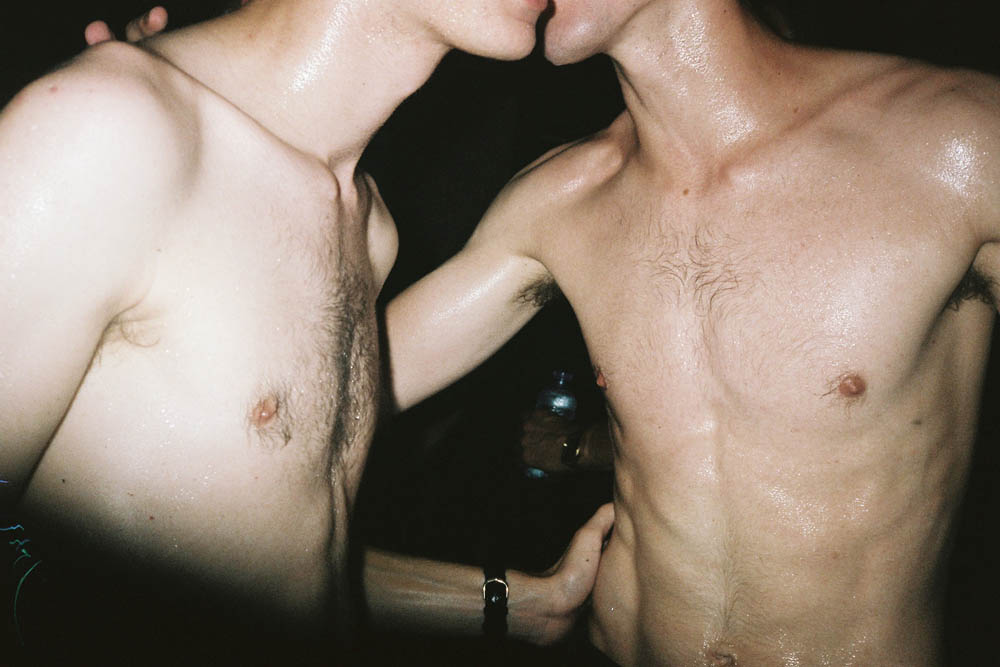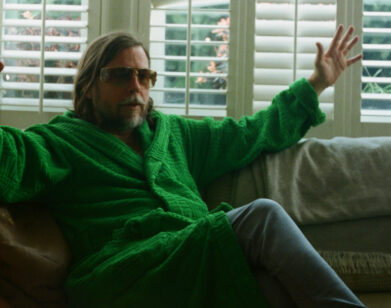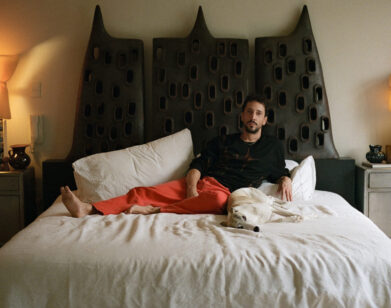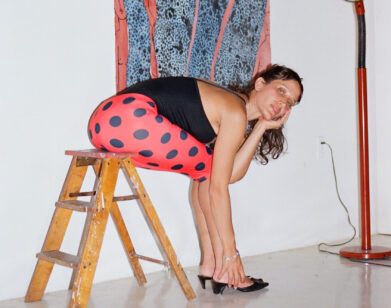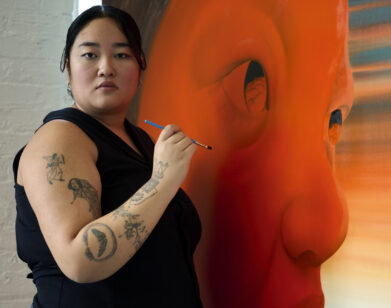Pierre-Ange Carlotti
First cigarette. The night is still young. I’m in a cab going north to the Ninth Arrondissement. There’s this new club in Pigalle. It’s called Le Carrousel, and it’s basically an old cabaret for cheap hookers and real hustlers that’s been transformed into a savage dance floor.
Second cigarette. The night is still young but very cold. It’s January. Finally winter has arrived, and you have the impression that the whole city holds its breath and hides under the quilt. There’s not a single scream harrowing the street. It’s supposed to be Saturday night—what’s going on? Paris has changed a lot. Pigalle used to be this dirty neighborhood, a sanctuary for all the weirdos and dangerous minds of the city. Now the crummy hostess bars are cocktail lounges and all the restaurants changed their menus from old steak frites you could barely swallow to burgers and bo bun. Classic gentrification. But still, if you know how to look between the lines, behind the red velvet drape and inside the hidden passage, maybe you can find something interesting.
Third cigarette. So here I am, standing strong like an old statue wearing Dr. Martens, in front of Le Carrousel, going in and passing the door guy like it is my personal garden. It’s midnight but the floor is empty. Weird. Something’s going on. I’m having my first vodka tonic of the night. That helps me to ask the right question: Who is DJ’ing? Behind the booth, I recognize Omaima Salem, one of the youngest and cutest French stylists. I don’t know her personally, but with Instagram, who cares about knowing people? You can understand what they’re up to as long as you have a Wi-Fi signal. I also identify this young and thin tornado with brown hair. It’s Paul Hameline, “it” boy of the year as they whisper in the offices of magazines. I like his style. Very punk. Very free. He’s dancing with himself and cares about no one. He’s wearing a Vetements jacket he probably kept from the last shoot he did modeling for them. Whatever. He’s drifting like a “bateau ivre” (the title of my favorite Rimbaud poem, about a drunken boat).
Vodka number two. My vision gets better. Oh, there’s another DJ up there. You can’t miss this one. He’s older, with a shaved head, a dark bomber jacket, a smart look and a naughty smile. It’s Gaspar Noé, the famous French director. When something fun happens in Paris by night, you can be sure that Gaspar is around. He always has the gift to find the right young people and put them together like pawns on the chessboard. The game is on.
Vodka number three. Last one was too short. Now I’m dancing. The club is still empty but you don’t need a forest to stand like a tree, do you? There’s another dancer next to me. I know him. Pierre-Ange Carlotti, the photographer à la mode. He is the eyes and memory of the young creative crew that has brought back energy and madness to Parisian nights. Pierre-Ange is sweet. He actually looks like Gaspar Noé—same skinhead, same black bomber jacket, same smile. Only he has dark eyes softer than Gaspar’s. We start to talk. About Paris. About the night. About the new clubs and the new drugs and the new sound and the new clothes. About the boys he likes. About the girls I like. About the fashion industry, the art industry, and the industry industry, which is everything and nothing.
Vodka number four. Plus two shots. One for Pierre-Ange, one for me. Now the club is full. Gaspar Noé is playing this ’80s French band called Niagara. The song is about a girl who’s going to have sex with a man, but right before the critical moment, she disappears into the night. When the chorus hits the floor, everyone starts to go wild, jumps and screams. Pierre-Ange comes up next to me and whispers in my ear, “You know, to me, this band, they’re the last romantics.”
Vodka number five. I’m at the bar, far from the chaotic bodies on the dance floor that are like one. I’m thinking about romanticism and the pictures of Pierre-Ange. Some people think they are too provocative because he shows naked ass. I think the opposite. Pierre-Ange has a sincere, honest look with no filter. He gives a true testimony of the freedom of the Parisian youth. Maybe that’s why some people are upset—he shows the truth.
Vodka number six. Now La Femme‘s music is playing. I’ve lost Pierre-Ange, but that’s okay, because we agree to meet in a much more quiet place and discuss all of this. All of this? Everything. His life. His work. His pictures. The rebirth of the Parisian underground scene. The influence of the gay and queer underworld. The fashion that tries to copy and suck up all of this energy.
La Femme is singing about wanting to be unisex. The dance floor looks like a giant human body with both sexes. It looks good. Maybe it’s time to go to bed. Well … the night is still young.
A week later, after the hangover, Pierre-Ange Carlotti is waiting for me at his place near the Place de la Bastille in the 11th Arrondissement to talk about everything. Let’s keep drinking water this time. It helps.
BORIS BERGMANN: So, Pierre-Ange, where are you from?
PIERRE-ANGE CARLOTTI: I was born on the 17th of June 1989, in Bastia, Corsica.
BERGMANN: Far from Paris …
CARLOTTI: Very far. Corsica is a special place, where the mountains abruptly meet the Mediterranean Sea. This special connection with nature explains the true character of Corsican people: very proud of their land, sometimes a little harsh and even wild. My family comes from a small village between Bastia and Porto Vecchio. My grandmother still has a bar and hotel restaurant there. She’s 90 years old but works more than ever.
BERGMANN: What was your childhood like with your parents?
CARLOTTI: My parents broke up a long time ago. My father is a shepherd, and to be honest, we haven’t spoken much since I was 8. It’s been a long time, and I think we are too different to get along. With my mother, it’s completely different. She’s my true ally. She understands everything about me. She was the one to help me to move to Paris. I remember her CDs in the living room growing up, music like Tina Turner and Jamiroquai. Music is essential when you’re a kid. I think it’s your front door to culture and art because music resounds inside of you—it touches your sensations and feelings. I told my mother that I was gay when I was 15. She totally supported me and has always been on my side.
BERGMANN: Was it hard to be a young gay boy in Corsica?
CARLOTTI: It’s hard everywhere. In any countryside, it’s hard to be born this way. But I actually think my Corsican temperament helped me to force the more reluctant elements to accept what I am. I remember in junior high school, three older guys were always bullying me, telling me I was a half boy, half girl and all of this kind of bullshit. One day, after hearing another insult, I faced the taller one and punched him in the face with all my strength and anger. Okay, he punched me back, but after that, I never heard any comments again. Just angry looks. But looks are easier to forget.
BERGMANN: Did you start to take pictures in Corsica?
CARLOTTI: Yes. I had a lot of girlfriends, most of them older than me. They used to take me to clubs and parties. I was only 12 at first, but I was like the little mascot of the group. It was fun and wild. Clubs in Corsica are not like Parisian nights, of course, but the parties are huge, especially during summer with all the tourists coming from the continent. We always stayed up all night long and ended up at the beach. I don’t remember how exactly it happened, but one of my friends gave me a disposable camera, and I started to take pictures of our nocturnal wanderings. I loved it immediately. Especially the next day when I’d go to the shop and develop the pictures—you never know what’s going to appear. It’s always an exciting moment. You have to wait an hour, then bam! A forgotten memory, a laugh, a dance, a kiss, a fist, an ass, a face, two eyes, a desire, love, sex … With all the pictures, you can reconstruct the night in your head. You have proof of what you did. Since this spontaneous initiation, I’ve always taken a disposable camera when I go out.
BERGMANN: So parties and pictures in Corsica … Then what?
CARLOTTI: I wanted more. And more means Paris. For every provincial, Paris is the dream, the center of attention, the ultimate goal. In French we say monter sur Paris, which means “going up to Paris,” like if the city were the summit of everything. It’s like New York City when you’re born in Arkansas or Kentucky. It’s the place you want to reach, the place you want to conquer. It’s the place that will make you be somebody.
BERGMANN: How did you escape Corsica?
CARLOTTI: Like many people of my generation, I would answer: the internet. To me, it was a magic word, truly essential in my life. With MySpace, you could meet new friends who live hundreds of miles from you but have the same tastes, all kinds of tastes—music, clothes, but also sexual orientation and unspoken desire. You have MSN Messenger, another great tool: You start to talk to them every night after school. I can still hear that sound of “whizz” that people sent you when your answers were too slow. Before I even put a foot in Paris, I had friends there, waiting to welcome me. After that, I made a few deals with my mom: good grades at school in exchange for a solo trip to the capital. Before I even graduated, I went to Paris a few times by myself, meeting my virtual friends, going to places I’d heard of for the first time. Like Noir Kennedy, for example, a famous clothing shop in le Marais, which was the first to sell Cheap Monday slim jeans and Dr. Martens shoes. These trips were also important because it was the first time I met other gay guys “for real.” In Corsica, there’s not a single gay bar or gay club. It’s a land of frustration. In Paris, I discovered that you can hit on people in the streets, go to a gay bar and not be judged, go to clubs with only men and wear what you want to wear, dance like you want to dance. It was the first time that I could be really like I wanted to be.
BERGMANN: Going back to Corsica must have been difficult.
CARLOTTI: In a way, yes, but I knew that I wouldn’t stay forever. So I graduated and moved to Paris. My mother didn’t know Paris that much and was a bit afraid of me living alone in the big city. So I found a place in Saint-Germain-des-Prés, a very bourgeois and touristy area.
BERGMANN: What did you do in Paris?
CARLOTTI: It’s funny. It was almost ten years ago that I moved—September 2007. I was a bit lost at the time. I had no idea what my life should be. I wanted to do everything, like most of the teenagers with creative minds do, I guess. First, I went to la Sorbonne to study French literature. I wanted to be a writer. I was going out a lot. Some magazines asked me to write some short articles about what was going on. I knew all about the gay scene, the secret parties and backroom stories. It wasn’t like today in Paris: gay and straight didn’t really party together, especially in the underground scene. So some magazines needed my knowledge because readers are always curious to know what’s going on in the world they don’t fully understand. I always had my camera on me but never published any pictures. I also started to write about fashion.
BERGMANN: Did you know fashion well?
CARLOTTI: For me, fashion is like photography: I learn everything in the field. And with the internet, the field has no borders. You can find an old ’90s campaign from Issey Miyake or an editorial from the forgotten French magazine Façade. You can build your own vocabulary without moving your ass from the sofa.
BERGMANN: So fashion was your next step after writing?
CARLOTTI: Not at all! After literature, I wanted to be an actor, so I went to a private acting school and almost got chosen for a movie, but it didn’t happen. At that time, I was living with my friend Clara 3000 [Clara Deshayes]. She’s this young, successful DJ who was playing almost everywhere when I arrived in Paris, from dirty warehouse parties to fancy fashion week events. It was perfect. We helped each other, finding the right energy. But, more importantly, she gave my first real camera. A Contax. I still work with the same model. We were on our way to New York for the first time, and she told me, “Pierre-Ange, you’re always taking pictures. Now do it right.” For the first time, I wanted to do more than just take pictures; I wanted to take nice pictures. I’m still influenced by that moment. For example, I never use a digital camera. I tried for the first time a few weeks ago when I had to shoot this catalog for a brand in a very short amount of time. It was so easy!
BERGMANN: What was the project that established you in the very closed Parisian fashion world?
CARLOTTI: I think it was my collaboration with Jacquemus [Simon Porte Jacquemus, founder and designer of the label Jacquemus]. I knew him for many years. He was from the South of France like me. Marseille, the city he grew up in, is the main entrance for all the Corsican diaspora. I helped Jacquemus to audition the models for his first three shows. He chose me to shoot an editorial he was styling. We shot six topless girls wearing pieces from his La Piscine collection. It was beautiful and full of light, just like his clothes. By the way, I think I bought the first Jacquemus piece. At the time, he was only 23. He was a baby and had staggering success, a success that was very important for people of my generation. Before Jacquemus, young people didn’t create a lot or nobody cared about what they did. Jacquemus opened the door for many young creators such as Vetements or the Marfa Journal crew.
BERGMANN: Not long after that, you had your first exhibition, in June 2014.
CARLOTTI: Yes, I began to make a name in underground fashion. Instagram helped me a lot. Today a young photographer doesn’t really need a gallery; he can show his work to the world in a very easy way. And let’s be honest, a high number of followers can bring you a lot of jobs and attention. Instagram is the new gallery. But I wanted to exhibit all the pictures of my friends. I had never shown their pictures before because I was too shy. I decided it was time. For that project, I took pictures of friends following the same ritual: I asked them to wear what they wanted, but the less the better. In the end, they always ended up almost naked. So I had my first idea: “Naked.” And then I needed to find something about myself to put into the show, so the title became “Bored and Naked.”
BERGMANN: Why “bored”?
CARLOTTI: Because I’d been lost and gone through a period of a harsh depression and hadn’t paid my rent for some months because no one pays a young photographer on time. I felt like I needed to expose this ennui. That was the best way to destroy it forever. So I found a gallery run by Antonine Catzéflis, a very bourgeois, eccentric woman. I remember her telling me, “This is great! We’re going to put dicks everywhere.” She let me do whatever I wanted. I even had the keys to the gallery for a whole month and a half after the opening to show my work whenever I wanted. I needed that freedom. The opening was amazing because all my friends from different circles came: fashion, gay, music, actors, etcetera. That show made me. After that, I started to work for bigger magazines like Purple. And I’m still working for them today! For my most recent editorial, I shot my two good friends, the models Mica Arganaraz and Jamie Bochert. The pictures I make for magazines are not different than the ones I make for my personal exhibitions …
BERGMANN: How would you define your style?
CARLOTTI: My pictures are a quest for intimacy. I try to be close to the people I work with. I want them to forget me if they’re naked, if they’re kissing, even if they are making love or taking drugs. Some people think that my pictures are provocative or trash. They’re just real, showing real people doing real stuff. And sometimes realness can be fun and naive and sweet. Even if you show a naked ass …
BERGMANN: Who are your main influences?
CARLOTTI: I would say Mapplethorpe. To me, he was the real master of photography in a very classical way. Terry Richardson is important, too—his relation to trash, to sexuality that he can capture with a brutal and direct flash, with no filter and no morals sometimes; he was a big influence. Movies, too, can be very important for a photographer. You know my love for Gaspar Noé. I call him Daddy, and I think he’s the godfather of Parisian youth. He understands our inner contradictions and never judges them.
BERGMANN: After “Bored and Naked,” you started to work with Vetements.
CARLOTTI: Vetements was a big step for me. I had known Lotta [Volkova, stylist for Vetements] for a long time, but I’d never worked with her. Then Demna [Gvasalia, head designer of Vetements and artistic director of Balenciaga] chose me. He’s a guru—you can’t influence his choice. He wanted me to shoot their first look book. The conditions were Dante-esque. I had to shoot 70 looks per day, in a huge flat, full of random assistants and friends. It was a mess. I had, like, two minutes for every picture. I think Demna chose me because he likes my style but also because he knew I could probably be the only one to endure those kinds of work conditions. It was the opposite of a classic fashion campaign. It was a joyous chaos. At the end, Demna decided we should make a book called Work in Progress, which basically told the whole adventure [of the brand’s Spring-Summer 2016 show in Paris], from the fittings to the after show.
BERGMANN: Vetements changed a lot of things in Paris.
CARLOTTI: They put the city back on the creative map. The clothes they make, they find it in the streets, in the way people wear them on a day-to-day basis. Demna went to Paris Charles De Gaulle Airport and saw that a security agent wore his jacket a certain way, so that’s the way it should be worn. They also took the energy of the night, of parties. Paris has changed a lot. When I arrived ten years ago, it was called the museum city because it was so sleepy. Of course, you had Le Baron, but it was a very classy and, in a way, an arrogant place. Very straight, too, because gay and queer didn’t mix in these kind of parties. Now you find places much more industrial, closer to the clubs in Berlin or Manchester. The styles are more punk. The hair is shorter, less bourgeois, less Parisian. All this new energy, young and wild, Vetements took from the streets and put it on a catwalk. And what a catwalk. Their third collection was shown at Le Dépôt, the most famous gay backroom of Paris. It was really audacious to bring fashion people to this kind of place they’re not used to going. The success was unexpected. But the whole team took advantage of it. We are a team—you have Vetements for the clothes, me for the pictures, young kids such as Paul Hameline for the poses, new magazines like Marfa Journal run by young people … It’s a family with the same goal: translate the energy of the streets, of our streets, into our art.
BERGMANN: What is your next project?
CARLOTTI: A new exhibition! It’s coming in June. I haven’t found the gallery yet, but I’m not afraid. This one is called “Bachelor.” I’m 27 today and realize that I haven’t really been part of a couple. I’ve only known violent passions but no coupledom. I’m the real bachelor. All my friends have started to be in serious relationships. So I’ve decided to capture these couples, so to speak, and put me in front of them. It’s going to be me, the single one, facing them, the couples. I think there’s real pressure in society to make people exist as twos. When an old lady dies alone, she’s a spinster even if she had a million adventures. I want to reject that prejudice and show what’s behind the couple: love sometimes, but also the fear of being lonely, disputes, sex …
BERGMANN: What are other dreams you have?
CARLOTTI: I want to work with Rihanna—she’s amazing. She’s one of the last divas. I also want to shoot a movie. I don’t want to put boundaries on my work: “You should do art and not fashion. You can’t shoot a movie if you’re a photographer. You should work for a big paper and not underground ones …” All of that is bullshit. I think the true advantage of our generation is that we want to do everything. Now let’s do it.
BORIS BERGMANN IS A PARIS-BASED WRITER. DÉSERTEUR, HIS MOST RECENT NOVEL, WAS RELEASED LAST SUMMER.

